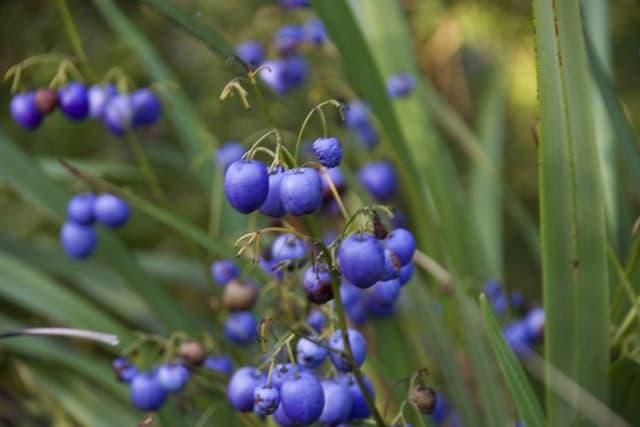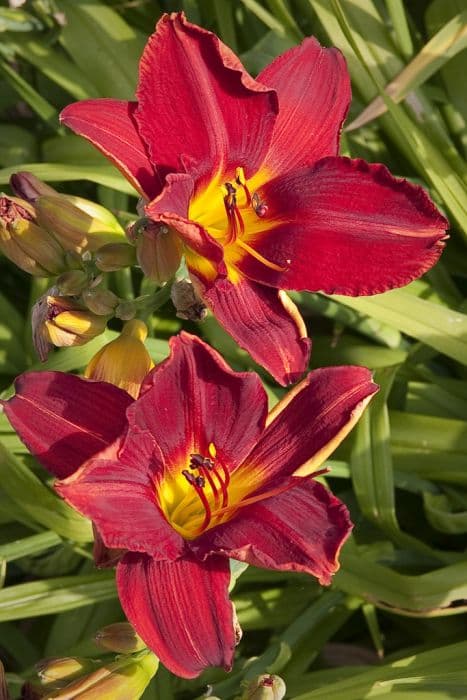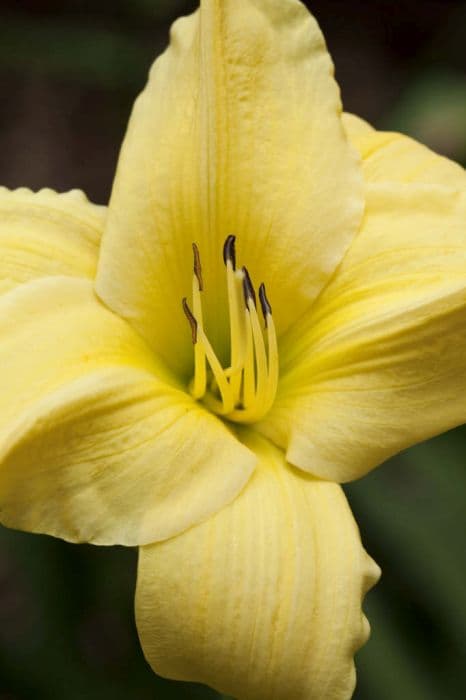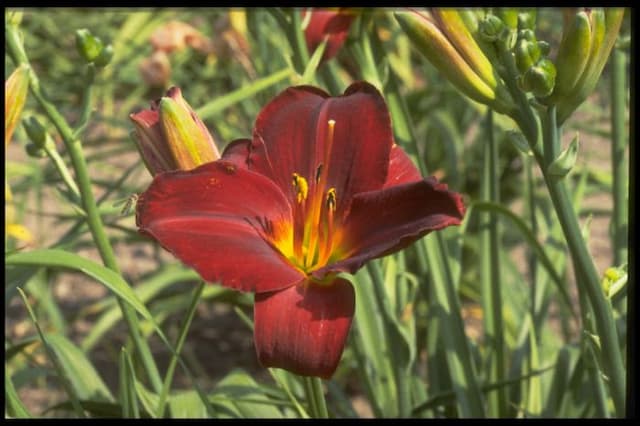Orange Daylily Hemerocallis fulva 'Green Kwanso' (d)

ABOUT
The 'Green Kwanso' is a captivating perennial with a distinctly lush appearance. Its striking flowers are an elaborate display of bright orange, with each petal showcasing a gradient of warm hues. These petals have a ruffled edge, adding to their voluminous and textured look. The center of the flower is accentuated by a deeper, richly colored throat, which provides a stunning contrast to the lighter tips of the petals. In the midst of the vibrant blossoms sit the stamens, adding an additional layer of intricacy with their slender forms and bold, prominent anthers at the tips. The foliage of the plant consists of long, arching leaves that have a strappy appearance, creating a fountain-like effect around the base of the flower stalks. These leaves display a bright to mid-green color, complementing the fiery tones of the blooms overhead. The overall look of the 'Green Kwanso' is filled with vitality and exuberance, with its abundant blooms and refreshing green foliage providing a spectacular show throughout its flowering period. The aesthetic of this plant is one of vigor and a flamboyant flair that makes it an attractive addition to any garden setting.
About this plant
 Names
NamesFamily
Hemerocallidaceae.
Synonyms
Orange Daylily, Tawny Daylily, Tiger Daylily, Ditch Lily, Roadside Daylily, Railroad Daylily, Outhouse Lily, Wash-house Lily, Double Kwanso Daylily, Triploid Kwanso, Kwanso Daylily.
Common names
Hemerocallis fulva var. kwanso, Hemerocallis fulva var. rosea, Hemerocallis kwanso.
 Toxicity
ToxicityTo humans
The common name of Hemerocallis fulva 'Green Kwanso' is the Orange Daylily. The Orange Daylily is considered non-toxic to humans and is actually edible in certain parts, particularly the flowers, which are sometimes used in culinary dishes. However, each individual may react differently, and it is possible for someone to have a sensitivity or allergic reaction to daylilies, as with any plant. If ingested by a person with a sensitivity, symptoms might include mild stomach upset, vomiting, or diarrhea. Always exercise caution and make sure plant identification is correct before consuming any plant material.
To pets
The Orange Daylily is known to be toxic to cats and potentially to dogs. For cats, the consumption of any part of this plant can lead to symptoms such as vomiting, lethargy, kidney failure, or even death. It is one of the many plants that contain compounds that are harmful to cats' kidney function. There is less information available on its toxicity to dogs, though it is generally recommended to prevent them from ingesting daylilies as well. If a pet has consumed any part of an Orange Daylily, it is important to seek veterinary care immediately. The toxicity can have serious consequences, and prompt treatment is crucial.
 Characteristics
CharacteristicsLife cycle
Perennials
Foliage type
Deciduous
Color of leaves
Green
Flower color
Orange
Height
2-3 feet (60-90 cm)
Spread
18-24 inches (45-60 cm)
Plant type
Herb
Hardiness zones
4
Native area
Asia
Benefits
 General Benefits
General Benefits- Easy to grow: Requires minimal maintenance and is adaptable to a variety of soil types.
- Drought tolerant: Once established, can withstand periods of limited rainfall.
- Erosion control: Its root system can help stabilize soil and prevent erosion.
- Attracts wildlife: Flowers can attract butterflies and other beneficial insects.
- Aesthetic appeal: Adds visual interest to gardens with its bright, showy flowers.
- Naturalizes easily: Can spread and fill in areas, creating a dense ground cover.
- Edible parts: Some parts of the plant are edible, traditionally used in certain cuisines.
- Long blooming period: Flowers from early summer to fall, providing a long season of color.
 Medical Properties
Medical Properties- Anti-inflammatory: Compounds in daylilies, like Hemerocallis fulva 'Green Kwanso', may have properties that help reduce inflammation.
- Antispasmodic: Traditionally, parts of the daylily are believed to have antispasmodic effects, which could relieve muscle spasms.
- Diuretic: It is said that daylilies can promote diuresis, aiding in the removal of excess water from the body.
- Febrifuge: Daylilies have been used historically to help reduce fever.
- Sedative: There are claims that some compounds in daylilies have a sedative effect, helping to induce relaxation or sleepiness.
- Analgesic: There may be pain-relieving properties associated with the use of daylilies in traditional medicine.
- Laxative: In some traditional practices, daylilies are used to aid digestion and act as a mild laxative.
 Air-purifying Qualities
Air-purifying QualitiesThis plant is not specifically known for air purifying qualities.
 Other Uses
Other Uses- Water Treatment: The roots of Daylilies can be used in constructed wetlands for treating greywater, as they can help in filtering and breaking down contaminants.
- Natural Dye: The flowers of Daylilies, especially the 'Green Kwanso', can be used to create a gentle yellow-green dye for textiles.
- Companion Planting: Daylilies can be planted with vegetables and fruits as they may deter certain pests with their strong scent or by attracting beneficial insects.
- Soil Erosion Control: The robust root system of Daylilies makes them suitable for stabilizing banks and slopes to prevent soil erosion.
- Pond Edging: Due to their hardiness and aesthetic value, Daylilies are used to edge ponds and water gardens, adding structure and color.
- Educational Tool: Daylilies can be used in schools and community gardens to teach about pollination and plant lifecycles due to their distinct flower structure.
- Sustainable Packaging: Dried and pressed Daylily leaves can be innovatively crafted into eco-friendly packaging materials for small items.
- Art Supplies: The sturdy, blade-like leaves of Daylilies can be used in paper-making or as a natural material for weaving projects.
- Culinary Presentation: Daylily petals can be used as an attractive and edible garnish for plating dishes in high-end culinary settings.
- Photography Subject: The distinct form and color of 'Green Kwanso' Daylilies make them a popular subject for botanical photographers and artists.
Interesting Facts
 Feng Shui
Feng ShuiDaylily is not used in Feng Shui practice.
 Zodiac Sign Compitability
Zodiac Sign CompitabilityDaylily is not used in astrology practice.
 Plant Symbolism
Plant Symbolism- Longevity and Perseverance: The 'Green Kwanso', also known as the Orange Daylily, is a hardy plant known for its ability to thrive with minimal care, symbolizing the ability to endure challenging conditions and representing a long life.
- Motherhood: In Chinese culture, daylilies are associated with motherhood and the devotion of mothers, due to the plant's nurturing appearance and growth habit.
- Forgotten or Lost Memories: Because the individual flowers of a daylily only bloom for one day before withering away, they can symbolize the fleeting nature of life and the forgetfulness of past memories.
- Renewal and the Cycle of Life: Each new day brings a fresh bloom on the daylily, signifying renewal, hope, and the ongoing cycle of life as one day fades and a new one begins.
 Water
WaterThe Orange Daylily should be watered deeply once a week, providing about 1 to 1.5 inches of water each time. During the peak of summer or in particularly hot climates, you may need to water twice a week to ensure the soil stays moist but not waterlogged. It's essential to water at the base of the plant to avoid wetting the foliage, which can lead to fungal diseases. Adjustments should be made for rainfall; if an inch of rain falls in a week, additional watering may not be necessary. When watering potted Orange Daylilies, ensure the equivalent of 1 gallon of water per week is received.
 Light
LightOrange Daylilies prefer full sun to partial shade but will flower best when they receive at least six hours of direct sunlight each day. The ideal spot for them is in an area where morning sun is abundant, and some afternoon shade is provided to protect from the intense heat of late day sun.
 Temperature
TemperatureOrange Daylilies are hardy and can tolerate temperatures ranging from just below freezing to about 90 degrees Fahrenheit, but they thrive in temperatures between 60 and 75 degrees Fahrenheit. They can survive brief dips down to 20 degrees Fahrenheit but aren't suitable for extreme, prolonged cold.
 Pruning
PruningOrange Daylilies benefit from pruning to remove spent flower stalks and dead foliage, which encourages reblooming and maintains a tidy appearance. These plants should be deadheaded regularly during the blooming season to promote more flowers. In late fall or early spring, cut back any old or damaged foliage to a few inches above the ground.
 Cleaning
CleaningAs needed
 Soil
SoilThe Orange Daylily 'Green Kwanso' thrives in a well-draining soil mix consisting of loamy or sandy soil with some organic matter. The best soil pH for this plant is slightly acidic to neutral, ranging from 6.0 to 7.0.
 Repotting
RepottingThe Orange Daylily 'Green Kwanso' typically does not require frequent repotting and can be repotted every 2 to 3 years or when the clump becomes crowded in its container.
 Humidity & Misting
Humidity & MistingThe Orange Daylily 'Green Kwanso' is tolerant of a wide range of humidity levels and does not have specific humidity requirements, making it quite adaptable to different outdoor conditions.
 Suitable locations
Suitable locationsIndoor
Ensure bright light and well-draining soil for Orange Daylily.
Outdoor
Plant in full sun to light shade, with well-drained soil for Orange Daylily.
Hardiness zone
3-9 USDA
 Life cycle
Life cycleHemerocallis fulva 'Green Kwanso', commonly known as the Double Orange Daylily, typically begins its life cycle when a seed germinates in spring, given adequate moisture and temperature conditions. The seedling emerges and develops into a juvenile plant with narrow, strap-like foliage. As it matures, it forms a clump of green leaves and begins to develop a root system, which includes both fibrous roots and tuberous rhizomes for nutrient storage and vegetative reproduction. In the following years, the daylily reaches reproductive maturity and during the early to midsummer it produces stems called scapes that bear distinctive double orange flowers. Each bloom on the scape only lasts for approximately one day, hence the name "daylily," and after pollination, the flowers may produce seed pods. The plant can also propagate asexually when sections of the rhizome are divided and replanted, and over the years, the original clump will expand, creating a larger stand of daylilies.
 Propogation
PropogationPropogation time
Late spring to early summer
The common name for Hemerocallis fulva 'Green Kwanso' is Daylily, and the most popular method of propagation for this plant is by dividing its rhizomes, typically done in the early spring or late summer after flowering has ceased. To propagate by division, carefully dig up the clump of daylilies and gently pull apart the rhizomes, ensuring that each division has at least one fan of leaves and a portion of the root system. These divided clumps can then be replanted at the same depth they were originally growing, spacing them about 18 to 24 inches (approximately 45 to 60 centimeters) apart to allow for growth and adequate air circulation. Water the newly planted divisions thoroughly to help establish them. Dividing the rhizomes rejuvenates the plant, encouraging more vigorous growth and abundant blooming in the following seasons.









